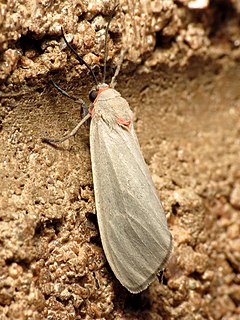
Lepidoptera is an order of insects that includes butterflies and moths. About 180,000 species of the Lepidoptera are described, in 126 families and 46 superfamilies, 10 per cent of the total described species of living organisms. It is one of the most widespread and widely recognizable insect orders in the world. The Lepidoptera show many variations of the basic body structure that have evolved to gain advantages in lifestyle and distribution. Recent estimates suggest the order may have more species than earlier thought, and is among the four most speciose orders, along with the Hymenoptera, Diptera, and Coleoptera.

Moths are a paraphyletic group of insects that includes all members of the order Lepidoptera that are not butterflies, with moths making up the vast majority of the order. There are thought to be approximately 160,000 species of moth, many of which have yet to be described. Most species of moth are nocturnal, but there are also crepuscular and diurnal species.

The Arctiinae are a large and diverse subfamily of moths, with around 11,000 species found all over the world, including 6,000 neotropical species. This group includes the groups commonly known as tiger moths, which usually have bright colours, footmen, which are usually much drabber, lichen moths, and wasp moths. Many species have "hairy" caterpillars that are popularly known as woolly bears or woolly worms. The scientific name of this subfamily refers to this hairiness. Some species within the Arctiinae have the word tussock in their common name due to people misidentifying them as members of the Lymantriinae based on the characteristics of the larvae.

The de Havilland DH.82 Tiger Moth is a 1930s British biplane designed by Geoffrey de Havilland and built by the de Havilland Aircraft Company. It was operated by the Royal Air Force (RAF) and many other operators as a primary trainer aircraft. In addition to the type's principal use for ab-initio training, the Second World War saw RAF Tiger Moths operating in other capacities, including maritime surveillance and defensive anti-invasion preparations; some aircraft were even outfitted to function as armed light bombers.
The Angelus is a Christian devotion.

The Phaegopterina are a subtribe of tiger moths in the tribe Arctiini, which is part of the family Erebidae. The subtribe was described by William Forsell Kirby in 1892.
Pygarctia is a genus of moths in the family Erebidae.

The Erebidae are a family of moths in the superfamily Noctuoidea. The family is among the largest families of moths by species count and contains a wide variety of well-known macromoth groups. The family includes the underwings (Catocala); litter moths (Herminiinae); tiger, lichen, and wasp moths (Arctiinae); tussock moths (Lymantriinae), including the arctic woolly bear moth ; piercing moths ; micronoctuoid moths (Micronoctuini); snout moths (Hypeninae); and zales, though many of these common names can also refer to moths outside the Erebidae. Some of the erebid moths are called owlets.
Pygarctia abdominalis, the yellow-edged pygarctia or orange-bodied pygarctia, is a moth in the family Erebidae. It was described by Augustus Radcliffe Grote in 1871. It is found in the United States from New Jersey south to Florida and west to Texas.
Pygarctia eglenensis, the gray-winged pareuchaetes, is a moth in the family Erebidae. It was described by James Brackenridge Clemens in 1861. It is found in the US states of Texas and Florida.
Pygarctia flavidorsalis is a moth in the family Erebidae. It was described by William Barnes and James Halliday McDunnough in 1913. It is found in the US states of Arizona and Texas. There is also a record for Oklahoma.
Pygarctia haematodes is a moth in the family Erebidae. It was described by Harrison Gray Dyar Jr. in 1921. It is found in Mexico.
Pygarctia lorula is a moth in the family Erebidae. It was described by Harrison Gray Dyar Jr. in 1914. It is found in the US state of New Mexico.
Pygarctia matudai is a species of moth in the family Erebidae. It was described by Carlos Rommel Beutelspacher in 1978. It is found in Mexico.

Pygarctia murina, the mouse-colored euchaetias, is a moth in the family Erebidae. It was described by Richard Harper Stretch in 1885. It is found in the United States in south-western Utah, from southern Colorado to south-eastern California and in southern Texas.
Pygarctia neomexicana is a moth in the family Erebidae. It was described by William Barnes in 1904. It is found in the US states of Texas, Arizona, Colorado, New Mexico and Utah.
Pygarctia pterygostigma is a moth in the family Erebidae. It was described by Harrison Gray Dyar Jr. in 1909. It is found in Mexico, and in the United States, in New Mexico and southern Texas.

Pygarctia roseicapitis, the red-headed pygarctia moth, is a moth in the family Erebidae. It was described by Berthold Neumoegen and Harrison Gray Dyar Jr. in 1893. It is found in Mexico and in the United States from southern Arizona to Texas.







